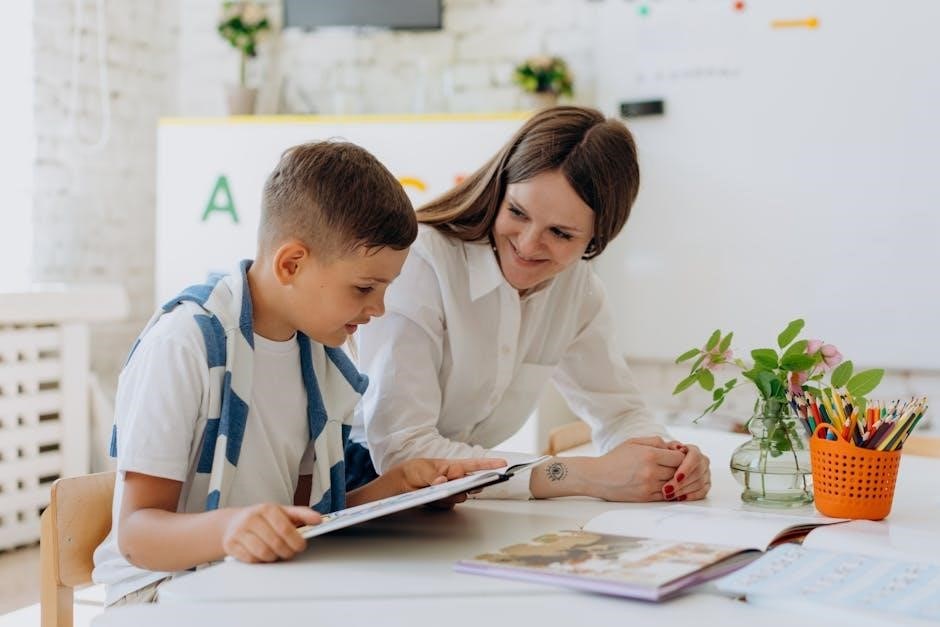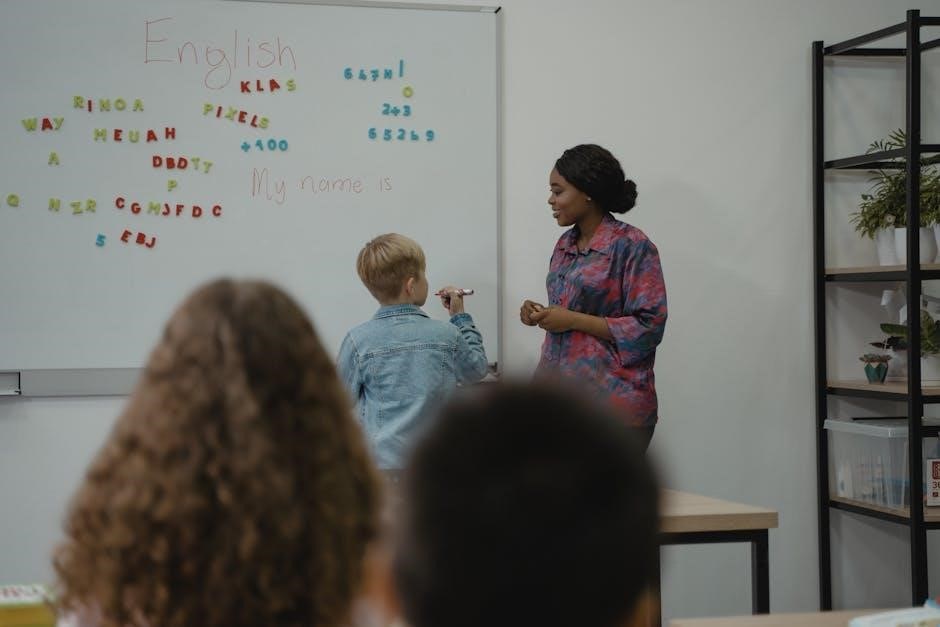a teacher’s guide to special education
Overview of Special Education
Special Education provides a framework for supporting students with diverse needs‚ ensuring access to education through legal protections like IDEA and Section 504. It emphasizes inclusive classrooms‚ individualized learning plans‚ and collaboration among educators‚ families‚ and specialists to empower students with disabilities.

1.1. Definition and Scope of Special Education
Special Education is tailored to meet the unique needs of students with disabilities‚ providing individualized instruction and support services. It ensures access to education through specialized interventions‚ accommodations‚ and modifications. The scope includes a range of services‚ from academic support to speech and occupational therapy‚ designed to address diverse learning‚ behavioral‚ and physical challenges. Aimed at fostering independence and promoting learning‚ Special Education serves as a critical framework for creating inclusive and supportive educational environments for all students.
1.2. Key Laws and Policies Governing Special Education
Special Education is governed by laws like the Individuals with Disabilities Education Act (IDEA)‚ Section 504 of the Rehabilitation Act‚ and the Americans with Disabilities Act (ADA). IDEA ensures a free and appropriate public education (FAPE) through Individualized Education Programs (IEPs). Section 504 prohibits discrimination against students with disabilities‚ requiring reasonable accommodations. These laws safeguard students’ rights‚ ensuring access to education and promoting inclusive practices. They guide educators in providing tailored support‚ fostering equity‚ and meeting the diverse needs of students with disabilities.
1.3. The Role of Special Education in Inclusive Classrooms
Special Education plays a pivotal role in fostering inclusive classrooms by ensuring students with diverse needs receive tailored support. It emphasizes collaboration between special and general education teachers‚ promoting shared responsibilities. Strategies like differentiated instruction‚ accommodations‚ and modifications are integral to meeting individual learning requirements. Inclusive practices break down barriers‚ enabling all students to participate meaningfully. By integrating special education principles‚ classrooms become spaces where diversity is celebrated‚ and every student has the opportunity to thrive academically‚ socially‚ and emotionally.

Roles and Responsibilities of Special Education Teachers

Special Education Teachers assess diverse student needs‚ develop IEPs‚ collaborate with general educators‚ and implement tailored strategies to ensure personalized learning and inclusive classroom success.
2.1. Working with Students with Diverse Needs
Special education teachers work with students having diverse needs‚ such as autism‚ ADHD‚ or learning disabilities‚ requiring personalized support and accommodations. They assess individual requirements‚ develop IEPs‚ and implement tailored strategies. Collaboration with general educators‚ therapists‚ and families ensures holistic support. Teachers adapt instruction using differentiated techniques‚ assistive technologies‚ and behavior management to meet unique challenges. Continuous professional development helps them address complex needs effectively‚ ensuring inclusive and equitable learning opportunities for all students. This role demands patience‚ creativity‚ and a commitment to fostering student growth and independence.
2.2. Collaboration with General Education Teachers
Collaboration between special and general education teachers ensures seamless support for students with diverse needs. Co-planning lessons‚ sharing resources‚ and aligning strategies foster an inclusive environment. Special education teachers provide expertise on accommodations and modifications‚ while general educators offer insights into curriculum and classroom dynamics. This partnership enhances student outcomes‚ promotes consistency‚ and strengthens the educational team. Effective communication and mutual respect are key to successful collaboration‚ ensuring all students receive tailored support and equitable opportunities to thrive academically and socially.
2.3. Developing Individualized Education Programs (IEPs)
Developing Individualized Education Programs (IEPs) is a collaborative process involving special education teachers‚ general educators‚ parents‚ and sometimes the student. An IEP outlines a student’s learning goals‚ necessary supports‚ and progress measurement. Special education teachers play a key role in identifying needs‚ setting objectives‚ and ensuring legal compliance under IDEA. The process includes assessing the student’s abilities‚ creating tailored goals‚ and establishing a plan for monitoring progress. While it is a formal process‚ the focus remains on addressing the student’s unique needs and ensuring access to a meaningful education.
Understanding Inclusive Education Practices

Inclusive education emphasizes creating supportive learning environments where all students‚ including those with disabilities‚ thrive together. It focuses on collaboration‚ differentiated instruction‚ and addressing diverse learner needs effectively.
3.1. Creating an Inclusive Classroom Environment
Creating an inclusive classroom involves designing a supportive space where all students feel valued and engaged. This includes fostering a positive atmosphere‚ using differentiated instruction‚ and incorporating assistive technology. Teachers must address diverse learning needs by adapting materials and strategies. Encouraging collaboration and respect among students is crucial. Clear classroom rules and routines help establish a structured yet welcoming environment. By promoting social-emotional learning and cultural sensitivity‚ educators ensure every student has the opportunity to succeed. Inclusive practices empower students with disabilities to fully participate and thrive in the classroom.

3.2. Differentiated Instruction for Special Needs Students
Differentiated instruction tailors teaching methods to meet the unique needs of all learners‚ including those with disabilities. Teachers assess students’ learning styles‚ strengths‚ and challenges to design tiered assignments‚ learning centers‚ and technology-integrated activities. This approach ensures that special needs students can access the curriculum while being challenged at their individual levels. Strategies include scaffolding‚ visual aids‚ and multisensory techniques. Differentiated instruction aligns with IEP goals and fosters collaboration between general and special education teachers‚ promoting an inclusive and engaging learning environment for all students.
3.3. Accommodations and Modifications for Learning
Accommodations and modifications are essential strategies to support students with special needs. Accommodations‚ such as extended time or assistive technology‚ help students access the curriculum without changing learning goals. Modifications‚ like simplified assignments‚ adjust the content to meet individual needs. Both strategies are tailored to IEP or 504 plans‚ ensuring students can engage meaningfully with the material. These adjustments promote inclusivity and equity‚ enabling students to demonstrate their knowledge and skills effectively while fostering independence and confidence in their learning journey.
Practical Strategies for Supporting Students
Practical strategies include behavior management techniques‚ assistive technology‚ and social-emotional learning support‚ ensuring students with diverse needs thrive in inclusive classrooms and achieve their full potential seamlessly.
4.1. Behavior Management Techniques
Effective behavior management techniques are essential for supporting students with diverse needs. Strategies include positive reinforcement‚ clear expectations‚ and de-escalation methods to create a calm learning environment. Tools like visual schedules and behavior charts help students understand expectations and track progress. Teachers can also use sensory supports and breaks to manage overwhelming situations. Consistent routines and collaboration with specialists ensure comprehensive support. These techniques promote social and academic growth‚ fostering a positive classroom culture for all students to thrive.
4.2. Assistive Technology for Special Needs
Assistive technology (AT) plays a vital role in empowering students with special needs. Tools like speech-to-text software‚ communication devices‚ and interactive learning apps cater to diverse learning challenges. Adaptive hardware‚ such as specialized keyboards‚ enables physical accessibility; These technologies promote independence‚ engagement‚ and confidence‚ helping students overcome barriers. Teachers must stay informed about emerging AT solutions to effectively integrate them into lesson plans‚ ensuring equitable learning opportunities for all students. By leveraging AT‚ educators can create a more inclusive and supportive educational environment tailored to individual needs.
4.3. Promoting Social and Emotional Learning
Social and emotional learning (SEL) is essential for students with special needs‚ fostering self-awareness‚ empathy‚ and healthy relationships. Teachers can integrate SEL through group activities‚ restorative practices‚ and explicit instruction. Strategies like mindfulness‚ role-playing‚ and reflective journaling help students manage emotions and develop resilience. By embedding SEL into daily routines‚ educators create a supportive environment that enhances students’ social skills‚ emotional well-being‚ and academic success. These practices also encourage collaboration and inclusion‚ benefiting all learners while addressing diverse needs effectively.
Challenges in Special Education
Special education faces challenges like teacher shortages‚ heavy workloads‚ and navigating legal requirements‚ impacting the ability to meet diverse student needs effectively and equitably.
5.1. Teacher Shortages and Workload Management
Teacher shortages in special education are a persistent issue‚ with 37 states reporting shortages. High workloads and complex responsibilities‚ such as managing IEPs and diverse student needs‚ contribute to burnout. Schools struggle to retain qualified educators‚ while the demand for specialized instruction grows. Programs offering incentives like signing bonuses aim to attract and retain teachers‚ but systemic challenges remain‚ affecting the quality of education for students with disabilities. Addressing these issues requires innovative solutions and support systems for educators.
5.2. Addressing the Needs of Diverse Learners
Teachers face challenges in addressing the diverse needs of students with varying disabilities‚ including autism‚ ADHD‚ and learning disabilities. Legal frameworks like IDEA and Section 504 ensure access to tailored support‚ but implementing these requirements can be complex. Professional development and collaboration between special and general education teachers are critical. Schools must provide resources and training to equip educators with strategies for differentiated instruction‚ accommodations‚ and behavioral support. These efforts ensure inclusive classrooms where all students‚ regardless of their abilities‚ can thrive and achieve their educational goals. Continuous improvement is essential to meet the evolving needs of diverse learners.
5.3. Navigating Legal and Administrative Requirements
Navigating legal and administrative requirements in special education can be complex‚ with laws like IDEA and Section 504 governing student rights. Teachers must understand these frameworks to ensure compliance‚ particularly in developing and implementing IEPs. Administrative tasks‚ such as documentation and progress monitoring‚ add to the workload. Legal jargon and evolving regulations can create challenges‚ requiring educators to stay informed. Non-compliance risks legal consequences‚ making professional development and support systems crucial for teachers to effectively manage these responsibilities while focusing on student outcomes and equitable education.

Supporting Teachers and Schools
Supporting teachers and schools involves providing professional development‚ resources‚ and collaborative environments to enhance special education practices and address teacher shortages‚ ensuring sustainable growth and student success.
6.1. Professional Development Opportunities
Professional development is crucial for special education teachers to enhance their skills and stay updated on best practices. On-demand courses‚ workshops‚ and certifications provide tailored learning experiences‚ addressing challenges like behavior management and assistive technology. These resources help educators refine their strategies for diverse learners‚ ensuring they can implement effective teaching methods. By investing in continuous learning‚ teachers gain confidence and competence‚ ultimately improving student outcomes and fostering inclusive education environments. such opportunities are essential for retaining skilled educators and addressing the growing demands of special education.
6.2. Building a Supportive School Community
Building a supportive school community involves fostering collaboration and inclusivity among teachers‚ students‚ and families. Initiatives like mentorship programs and peer support networks help create a positive environment. Professional development opportunities and resource sharing encourage educators to work together effectively. Schools can also promote inclusivity by celebrating diversity and addressing barriers for students with special needs. By fostering a culture of empathy and shared responsibility‚ schools ensure all students feel valued and supported‚ leading to improved academic and social outcomes for everyone.
6.3. Resources for Continuous Improvement
Resources for continuous improvement in special education include professional development programs‚ guidebooks‚ and online courses. Tools like “A Teacher’s Guide to Special Education” provide insights into laws and practices. Workshops and webinars offer hands-on training‚ while assistive technology tools enhance student support. Schools can also leverage collaborative platforms to share strategies and materials. These resources empower educators to refine their methods‚ ensuring they meet the evolving needs of students with special needs and stay compliant with legal requirements.